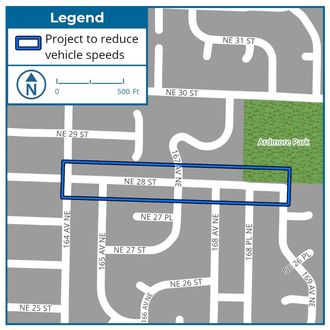The City of Bellevue Transportation Department has heard from people in Northeast Bellevue about speeding concerns on NE 28th Street between 164th Avenue NE and Ardmore Park (169th Avenue NE). This portion of NE 28th Street was evaluated against all other requests for traffic calming in the city—a list of 100 locations—and was rated highly for action given vehicle speeds, community support, and proximity to parks and schools.
We often try to implement multiple treatments along a corridor to maximize the potential speed reduction impact. Countermeasures will be selected based on design considerations, community feedback, desired goals, and budget. A survey was previously held during summer 2024 to gather community feedback. Thank you to everyone who completed the survey. Staff are currently analyzing the results and determining a scope of work based on the results.
Documents
- Survey mailer (August 2024)
- Survey yard sign (August 2024)

